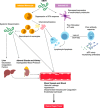Molecular mechanisms of Ebola pathogenesis
- PMID: 27587404
- PMCID: PMC6608070
- DOI: 10.1189/jlb.4RI0316-099RR
Molecular mechanisms of Ebola pathogenesis
Abstract
Ebola viruses (EBOVs) and Marburg viruses (MARVs) are among the deadliest human viruses, as highlighted by the recent and widespread Ebola virus outbreak in West Africa, which was the largest and longest epidemic of Ebola virus disease (EVD) in history, resulting in significant loss of life and disruptions across multiple continents. Although the number of cases has nearly reached its nadir, a recent cluster of 5 cases in Guinea on March 17, 2016, has extended the enhanced surveillance period to June 15, 2016. New, enhanced 90-d surveillance windows replaced the 42-d surveillance window to ensure the rapid detection of new cases that may arise from a missed transmission chain, reintroduction from an animal reservoir, or more important, reemergence of the virus that has persisted in an EVD survivor. In this review, we summarize our current understanding of EBOV pathogenesis, describe vaccine and therapeutic candidates in clinical trials, and discuss mechanisms of viral persistence and long-term health sequelae for EVD survivors.
Keywords: Ebola survivors; Ebola vaccines; antivirals; immunoevasion; viral hemorrhagic fever.
© Society for Leukocyte Biology.
Figures




Similar articles
-
Ebola Virus: Pathogenesis and Countermeasure Development.Annu Rev Virol. 2019 Sep 29;6(1):435-458. doi: 10.1146/annurev-virology-092818-015708. Annu Rev Virol. 2019. PMID: 31567063 Review.
-
Treatment of ebola virus disease.Pharmacotherapy. 2015 Jan;35(1):43-53. doi: 10.1002/phar.1545. Pharmacotherapy. 2015. PMID: 25630412 Review.
-
Ebola Virus Transmission Caused by Persistently Infected Survivors of the 2014-2016 Outbreak in West Africa.J Infect Dis. 2018 Nov 22;218(suppl_5):S287-S291. doi: 10.1093/infdis/jiy280. J Infect Dis. 2018. PMID: 29920602 Free PMC article. Review.
-
Potential Impact of Sexual Transmission on Ebola Virus Epidemiology: Sierra Leone as a Case Study.PLoS Negl Trop Dis. 2016 May 2;10(5):e0004676. doi: 10.1371/journal.pntd.0004676. eCollection 2016 May. PLoS Negl Trop Dis. 2016. PMID: 27135922 Free PMC article.
-
Distinct Immunogenicity and Efficacy of Poxvirus-Based Vaccine Candidates against Ebola Virus Expressing GP and VP40 Proteins.J Virol. 2018 May 14;92(11):e00363-18. doi: 10.1128/JVI.00363-18. Print 2018 Jun 1. J Virol. 2018. PMID: 29514907 Free PMC article.
Cited by
-
Transcriptional Analysis of Lymphoid Tissues from Infected Nonhuman Primates Reveals the Basis for Attenuation and Immunogenicity of an Ebola Virus Encoding a Mutant VP35 Protein.J Virol. 2021 Feb 24;95(6):e01995-20. doi: 10.1128/JVI.01995-20. Print 2021 Feb 24. J Virol. 2021. PMID: 33408171 Free PMC article.
-
Therapeutic vaccination strategies against EBOV by rVSV-EBOV-GP: the role of innate immunity.Curr Opin Virol. 2021 Dec;51:179-189. doi: 10.1016/j.coviro.2021.10.007. Epub 2021 Nov 5. Curr Opin Virol. 2021. PMID: 34749265 Free PMC article. Review.
-
A Comparative NLP-Based Study on the Current Trends and Future Directions in COVID-19 Research.IEEE Access. 2021 May 20;9:78341-78355. doi: 10.1109/ACCESS.2021.3082108. eCollection 2021. IEEE Access. 2021. PMID: 34786315 Free PMC article.
-
Packaging of Rift Valley fever virus pseudoviruses and establishment of a neutralization assay method.J Vet Sci. 2018 Mar 31;19(2):200-206. doi: 10.4142/jvs.2018.19.2.200. J Vet Sci. 2018. PMID: 28693302 Free PMC article.
-
Recent Advances in Therapeutic Approaches Against Ebola Virus Infection.Recent Adv Antiinfect Drug Discov. 2024;19(4):276-299. doi: 10.2174/0127724344267452231206061944. Recent Adv Antiinfect Drug Discov. 2024. PMID: 38279760 Review.
References
-
- Feldmann, H. , Slenczka, W. , Klenk, H. D. (1996) Emerging and reemerging of filoviruses. Arch. Virol. Suppl. 11, 77–100. - PubMed
-
- Slenczka, W. , Klenk, H. D. (2007) Forty years of Marburg virus. J. Infect. Dis. 196 (Suppl 2), S131–S135. - PubMed
-
- Siegert, R. , Shu, H. L. , Slenczka, W. , Peters, D. , Müller, G. (1967) On the etiology of an unknown human infection originating from monkeys [in German]. Dtsch. Med. Wochenschr. 92, 2341–2343. - PubMed
-
- Towner, J. S. , Khristova, M. L. , Sealy, T. K. , Vincent, M. J. , Erickson, B. R. , Bawiec, D. A. , Hartman, A. L. , Comer, J. A. , Zaki, S. R. , Ströher, U. , Gomes da Silva, F. , del Castillo, F. , Rollin, P. E. , Ksiazek, T. G. , Nichol, S. T. (2006) Marburgvirus genomics and association with a large hemorrhagic fever outbreak in Angola. J. Virol. 80, 6497–6516. - PMC - PubMed
-
- Bausch, D. G. , Nichol, S. T. , Muyembe‐Tamfum, J. J. , Borchert, M. , Rollin, P. E. , Sleurs, H. , Campbell, P. , Tshioko, F. K. , Roth, C. , Colebunders, R. , Pirard, P. , Mardel, S. , Olinda, L. A. , Zeller, H. , Tshomba, A. , Kulidri, A. , Libande, M. L. , Mulangu, S. , Formenty, P. , Grein, T. , Leirs, H. , Braack, L. , Ksiazek, T. , Zaki, S. , Bowen, M. D. , Smit, S. B. , Leman, P. A. , Burt, F. J. , Kemp, A. , Swanepoel, R. ; International Scientific and Technical Committee for Marburg Hemorrhagic Fever Control in the Democratic Republic of the Congo . (2006) Marburg hemorrhagic fever associated with multiple genetic lineages of virus. N. Engl. J. Med. 355, 909–919. - PubMed
Publication types
MeSH terms
Substances
Grants and funding
LinkOut - more resources
Full Text Sources
Other Literature Sources
Medical

